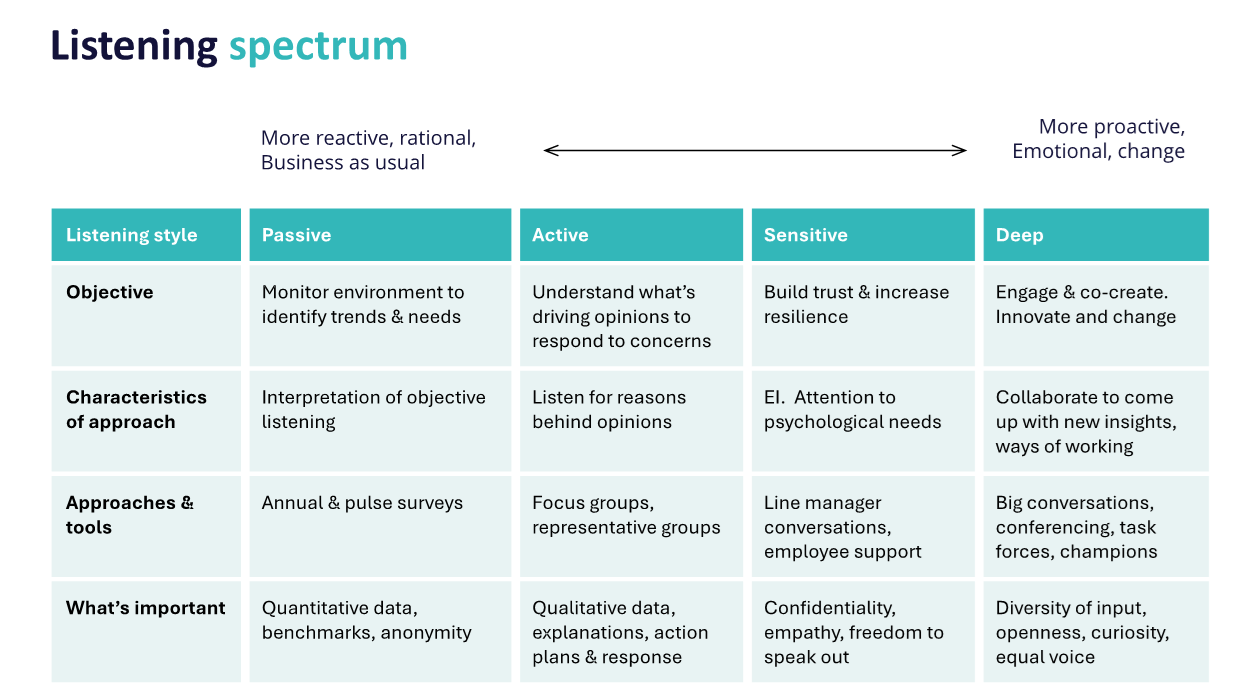Most employees say that their health — physical, mental, financial and social — worsened or stayed the same in 2023. Yet 80% of executives think their workforce’s health has improved. This alarming difference provides a stark illustration of the gap between leaders’ and employees’ perspectives.
This finding emerged in research from a well-being survey conducted by Deloitte, which questioned over 1,000 employees and 1,000 C-suite executives. Results showed that post pandemic employees are feeling stressed, exhausted and overworked, and executives haven’t necessarily understood how employees feel.
Leaders need help and support to listen better, especially when it comes to well-being. Sensitive listening can help address some employees’ concerns.
Since 2018, Howard Krais, Kevin Ruck and I have been researching listening. What we’ve found mirrors Deloitte’s discovery: leaders believe they listen to their employees far better than employees think they are being listened to. This has created a concerning gap where leaders may overlook critical insights necessary for safeguarding the overall health of their organization and well-being of their people.
This is particularly worrying, as a lack of support around well-being appears to be driving unwanted and damaging trends in the workplace. One standout statistic is from the U.K. Chartered Institute for Personnel and Development (CIPD) report, where sickness absence is now averaging two days more per person than in 2019. The pandemic, economic turmoil, changing patterns of work and levels of loyalty and engagement may all play a part.
Organizations must understand issues such as presenteeism and declining levels of engagement in order to develop strategies that address these challenges. Yet, Claudia Nicholls-Magielsen of Simplyhealth said in the CIPD report that, “senior leaders’ interest in these strategies appears to be waning, despite it increasing during COVID-19.”
Challenges for Communicators
Our research on listening started before the pandemic and carried on during and after its peak. Employee well-being and listening to employees’ concerns were front and center priorities for numerous executive groups during the pandemic. Now, executive focus seems to have moved on, as noted in the CIPD report.
These findings highlight two critical and related challenges facing communicators:
- How to focus the leadership’s attention on long-term issues like well-being before they become short-term crises, threatening ongoing operations.
- How to challenge assumptions and biases about the way things are, which stops leadership from seeing issues the business faces.
These dilemmas are not easy to fix, but what can help is shifting the way the communicator assists the leadership team in listening, incorporating emotion and storytelling into their portfolio of approaches.
How Listening Can Help
Surveys dominate how organizations listen to employees. Our research in 2020 found that 59% of organizations that responded used surveys on a regular basis. In the 2024 State of the Sector survey report from Gallagher, engagement surveys ranked first in usage by 75% of organizations, with an even higher effectiveness rating of 79%.
It’s easy to see why. If well designed, surveys appear to remove bias, track trends, ease comparisons, enable statistical analysis and contribute toward an analytical approach to any issue.
But surveys also often take a long time to process and don’t always seem to lead to action. They feel impersonal and reactive, which means that:
- People don’t feel like they’ve have been heard.
- Leaders have not experienced strength of feeling (they are often shielded from this).
- Surveys rarely provide any solutions (except through optional write-in comments).
While surveys have great strengths, they fail to generate an emotional nudge for leaders to stimulate decision making and ultimately drive change. They also don’t sit well in isolation for addressing some topics.
When it comes to well-being, the way we listen can help address some of the things that affect it, like stress, recognition, purpose and belonging. Listening to employees is an intervention that needs to be tailored to the outcomes we want to achieve.
It’s noticeable that Gallagher found the only two listening approaches ranked higher for effectiveness, but much lower in usage are listening sessions at 85% effectiveness and leader sessions at 82%. These methods may look different across different organizations but are likely characterized by face-to-face or online interactive conversations and the involvement of leadership. We too found that opportunities for direct listening were highly valued and much less frequently used.
A Portfolio of Approaches: The Listening Spectrum
Where does this leave communicators in terms of actionable steps? The task at hand is to combine listening that treads a balance between rational, evidence-based analysis for organizational health and emotive, interpersonal, impactful listening that feels empathetic for employees and insightful for leaders.
The Listening Spectrum, as seen below, can help communicators think about options at their disposal. It provides a range of different listening approaches to suit different needs.

The left-hand side of the spectrum covers the processes used most frequently in listening to employees that are designed to monitor and understand perspectives. On the right-hand side are processes better suited to more emotive topics, such as well-being and when the organization seeks change.
Leading effective listening within organizations can cover a broad range of approaches and help bridge the listening gap. As communicators, it’s well within our grasp to use a wide portfolio of tools to achieve better outcomes, enhancing the employee experience and improving well-being and improving the insights provided to operational leadership. At the end of the day, it’s not just a good thing to do, it’s a better approach to business.
Mike PounsfordMike Pounsford is the founder of Couravel, a Communication Consulting firm and past president of IABC U.K. He co-authored “Leading the Listening Organization: Creating Organizations that Flourish” with Kevin Ruck and Howard Krais, published in 2024. IABC members can get a 20% discount if they use the code LTLO20 at check out on the Routledge site.